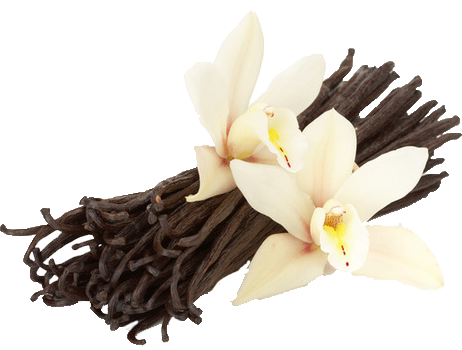|
Vanilla beans are
one of the expensive non-pungent spices especially used as flavouring purpose
in a wide array of sweet drinks and confectionaries.
Vanilla extract
composed of simple and complex sugars, essential oils, vitamins and minerals.
The main chemical
components in the beans are vanillin and numerous traces of other constituents
such as eugenol, caproic acid, phenoles, phenol ether, alcohols, carbonyl
compounds, acids, ester, lactones, aliphatic and aromatic carbohydrates and
vitispiranes.
Vanilla drink was
thought to have aphrodisiac qualities, however no research studies establishes
its role in the treatment of erectile dysfunction.
The extract
contains small amounts of B-complex group of vitamins such as niacin,
pantothenic acid, thiamin, riboflavin and vitamin B-6. These B-complex groups
of vitamins help in enzyme synthesis, nervous system function and regulating
body metabolism.
This spice also
contains small traces of minerals such as calcium, magnesium, potassium,
manganese, iron and zinc. Potassium in an important component of cell and
body fluids that helps control heart rate and blood pressure. Manganese and
copper are used by the body as co-factors for the antioxidant enzyme superoxide
dismutase. Iron is essential for red blood cell production and as a co-factor
for cytochrome oxidases enzymes.
Increased libido: Since ancient times, vanilla has been regarded an aphrodisiac.
However, ongoing aromatherapy studies suggest that vanilla may increase sexual
desire by boosting testosterone levels in men. A 1970s study also claimed that
majority of its participants believed that vanilla had cured their impotency.
While there is no concrete evidence to prove this, experts believe that the
aroma of vanilla does induce feelings of pleasure and satiation.
Skin disorders: Antibacterial properties of vanillin help cleanse skin problems
such as pimples and acne. Moreover, antioxidant properties of vanilla help
fight the damage caused by free radicals. It may even help slow signs of aging.
The cosmetic industry uses vanilla both for its fragrance as well as anti-aging
properties.
Burns: Traditionally, home remedies to heal burns, cuts, and wounds
have used vanilla. However, it is perhaps unsafe to use concentrated vanilla
extract or essential oil on recent burns. Topical treatments containing vanilla
may prove beneficial; however, talk to your doctor before you try any home
remedies or natural treatment for burns.
Coughing: Cough syrups often use vanilla flavouring to mask bitter tastes.
Although there is little evidence to prove the effect of vanilla extract on
coughing, the mild anaesthetic properties may relieve symptoms such as pain
from a sore throat or headache.
Toothache: Vanillin found in vanilla falls under the same category of
vanilloids that include capsaicin from chilli peppers and eugenols from spices
such as cinnamon. Both these active compounds have an effect on the central
nervous system. Capsaicin acts as a pain reliever, while eugenols work
effectively as topical anaesthetics. These mirroring properties in vanilla may
help you fight a toothache and infection.
Antioxidant: Most frequently studied as a component of other substances,
vanillin is known for its antioxidant properties. The wide range of potential
applications that antioxidant-rich substances have make them important for both
research and inclusion in our plant-based preparations. Antioxidants battle
free radical damage and repair its effects, which means they make important
changes at a cellular level. This implicates antioxidants in everything from
mucosal healing to cancer battling to skin rejuvenation.
Antibacterial : In a rare test of actual vanilla oil, researchers evaluated
the efficacy of vanilla oil for inhibiting certain bacteria. The testing also
evaluated ylang ylang and patchouli oils. For the bacteria in question – a
strain of Staph. – vanilla was able to inhibit its development. Essential oils
with antibacterial benefits are extremely useful. In today’s age of chemical
synthetics and overuse, we find ourselves with more harm than benefit when
using commercial antibacterial products. To stop the spread of dangerous
bacteria without risking our health is invaluable!
Anticancer: As usual with cancer and essential oils, the preface for this
discussion is that more research must be executed. Thanks in no small part to
its antioxidant ability, though, vanillin and substances that contain it (like
vanilla!) are among the oils and compounds considered for anticancer ability. Until
we know more specifically how these actions work in the body and the best ways
to incorporate them for direct efficacy, we can enjoy using a substance that
cancer doesn’t like!
Anti-inflammatory: Also in line with the effects of antioxidants, vanillin is likely
to be anti-inflammatory. This effect tends to happen with antioxidant
substances thanks to that cellular level repair that takes place. As a
non-traditional oil, topical applications are excellent for executing this
effect, massaging it deep into the muscles and joints that are inflamed or
applying it to skin that is plagued with inflammation.
Antidepressant: Essential oils are often used for their uplifting,
antidepressant abilities thanks to their simple applications and quick results.
It never ceases to amaze me that simply smelling a fragrance can so quickly and
effectively reach and affect the brain!
Vanillin has been studied for its in vitro
ability to relieve depression. Tracking markers of depression in mice,
researchers were able to determine antidepressant activity with the vanillin
compound. While every body is different and nothing should take the place of
professional help for depression, news of a new compound that may help relieve
depression is always welcome.
|

